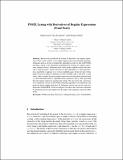Files in this item
POSIX lexing with derivatives of regular expressions (proof pearl)
Item metadata
| dc.contributor.author | Ausaf, Fahad | |
| dc.contributor.author | Dyckhoff, Roy | |
| dc.contributor.author | Urban, Christian | |
| dc.contributor.editor | Blanchette, Jasmine Christian | |
| dc.contributor.editor | Merz, Stephan | |
| dc.date.accessioned | 2016-09-12T09:30:18Z | |
| dc.date.available | 2016-09-12T09:30:18Z | |
| dc.date.issued | 2016 | |
| dc.identifier | 245601547 | |
| dc.identifier | 1c6a22ab-6956-4699-8525-e15b0a70a056 | |
| dc.identifier | 84984782921 | |
| dc.identifier | 000417366000005 | |
| dc.identifier.citation | Ausaf , F , Dyckhoff , R & Urban , C 2016 , POSIX lexing with derivatives of regular expressions (proof pearl) . in J C Blanchette & S Merz (eds) , Interactive Theorem Proving : 7th International Conference, ITP 2016, Nancy, France, August 22-25, 2016, Proceedings . Lecture Notes in Computer Science , vol. 9807 , Springer , pp. 69-86 , ITP 2016: Interactive Theorem Proving , Nancy , France , 22/08/16 . https://doi.org/10.1007/978-3-319-43144-4_5 | en |
| dc.identifier.citation | conference | en |
| dc.identifier.isbn | 9783319431437 | |
| dc.identifier.isbn | 9783319431444 | |
| dc.identifier.issn | 0302-9743 | |
| dc.identifier.uri | https://hdl.handle.net/10023/9472 | |
| dc.description.abstract | Brzozowski introduced the notion of derivatives for regular expressions. They can be used for a very simple regular expression matching algorithm. Sulzmann and Lu cleverly extended this algorithm in order to deal with POSIX matching, which is the underlying disambiguation strategy for regular expressions needed in lexers. Sulzmann and Lu have made available on-line what they call a “rigorous proof” of the correctness of their algorithm w.r.t. their specification; regrettably, it appears to us to have unfillable gaps. In the first part of this paper we give our inductive definition of what a POSIX value is and show (i) that such a value is unique (for given regular expression and string being matched) and (ii) that Sulzmann and Lu’s algorithm always generates such a value (provided that the regular expression matches the string). We also prove the correctness of an optimised version of the POSIX matching algorithm. Our definitions and proof are much simpler than those by Sulzmann and Lu and can be easily formalised in Isabelle/HOL. In the second part we analyse the correctness argument by Sulzmann and Lu and explain why the gaps in this argument cannot be filled easily. | |
| dc.format.extent | 18 | |
| dc.format.extent | 99984 | |
| dc.language.iso | eng | |
| dc.publisher | Springer | |
| dc.relation.ispartof | Interactive Theorem Proving | en |
| dc.relation.ispartofseries | Lecture Notes in Computer Science | en |
| dc.subject | POSIX matching | en |
| dc.subject | Derivatives of regular expressions | en |
| dc.subject | Isabelle/HOL | en |
| dc.subject | BC Logic | en |
| dc.subject | QA75 Electronic computers. Computer science | en |
| dc.subject | NDAS | en |
| dc.subject.lcc | BC | en |
| dc.subject.lcc | QA75 | en |
| dc.title | POSIX lexing with derivatives of regular expressions (proof pearl) | en |
| dc.type | Conference item | en |
| dc.contributor.institution | University of St Andrews. School of Computer Science | en |
| dc.contributor.institution | University of St Andrews. Centre for Interdisciplinary Research in Computational Algebra | en |
| dc.identifier.doi | 10.1007/978-3-319-43144-4_5 |
This item appears in the following Collection(s)
Items in the St Andrews Research Repository are protected by copyright, with all rights reserved, unless otherwise indicated.

